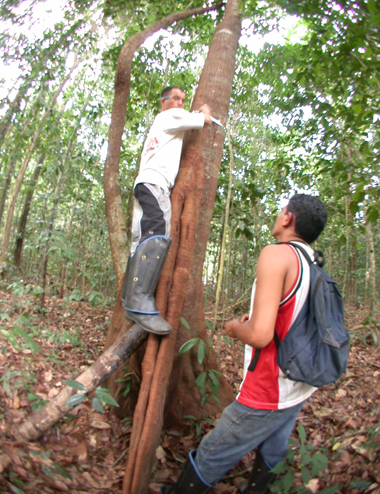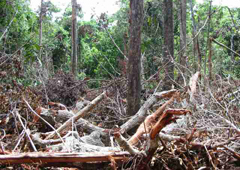Reduced-Impact Logging in Tropical Rainforest Can Be Economical While Significantly Reducing Carbon Emissions
UAlbany Atmospheric Scientist Scott Miller Led International Research Team
 |
|
Albert de Sousa (on ladder) and Augusto Maia, two students from Brazil's Federal University of Para, measure the circumference of an Amazon rainforest tree in order to estimate its carbon content. Part of a study on reduced-impact logging conducted by UAlbany's Scott Miller, this was but one of thousands of trees so assessed.
|
The study, led by Scott Miller, Ph.D., at UAlbany's Atmospheric Sciences Research Center, was published this month in the official journal of the National Academy of Sciences, Proceedings of the National Academy of Sciences. Entitled "Reduced-impact logging minimally alters tropical rainforest carbon and energy exchange," the study was funded by the National Aeronautics and Space Administration as part of the Large Scale Biosphere-Atmosphere Experiment in Amazonia, a Brazilian-led project.
For decades, scientists and foresters have debated how best to reap economic benefits from tropical rainforests while maintaining their high biodiversity and critical roles in the global carbon, energy and water cycles. In an unprecedented comparison of a logged tropical forest with an intact forest ecosystem, Miller and researchers from several American and Brazilian universities measured the exchanges of carbon dioxide and water between forests and the atmosphere.
In RIL, loggers cut the heavy vines that connect trees and direct where harvested trees will fall. Applying this method, significantly fewer surrounding trees are damaged or killed when the target logs fall than in conventional selective logging.
 |
|
Reduced impact logging employed by Scott Miller's team causes a biomass of branches to be left on the forest floor after logging. This will eventually decompose and release its carbon to the atmosphere as carbon dioxide.
|
Miller and the team monitored the air exchanges from two 213-foot towers that extended above the forest canopy. One tower was in an area of forest that was selectively logged, and the other was in area that was not logged. Detailed measurements of the carbon exchange and the carbon stocks in live and dead trees showed that the forest lost carbon to the atmosphere in the first year after logging but thereafter the forest carbon balance returned to pre-logging levels.
"We found that the net carbon emissions caused by RIL were just a few percent of what would have been released in deforestation," said Miller.
Similarly, RIL had a small, transient effect on forest-atmosphere water exchange. According to Humberto da Rocha, professor of atmospheric sciences at the University of Sao Paulo and collaborator on the project, "evaporation declined briefly, but forest-atmosphere water exchange returned to pre-logging levels within a year."
Logging is a profitable land use in the Brazilian Amazon. Using conventional methods, it can be highly destructive and degrade forest-functioning. Miller's study shows, however, that using RIL methods can be economically beneficial while having minimal impact on forest-atmosphere carbon and water exchange.
![]() For more news, subscribe to UAlbany's RSS headline feeds
For more news, subscribe to UAlbany's RSS headline feeds
A comprehensive public research university, the University at Albany-SUNY offers more than 120 undergraduate majors and minors and 125 master's, doctoral and graduate certificate programs. UAlbany is a leader among all New York State colleges and universities in such diverse fields as atmospheric and environmental sciences, business, education, public health,health sciences, criminal justice, emergency preparedness, engineering and applied sciences, informatics, public administration, social welfare and sociology, taught by an extensive roster of faculty experts. It also offers expanded academic and research opportunities for students through an affiliation with Albany Law School. With a curriculum enhanced by 600 study-abroad opportunities, UAlbany launches great careers.


